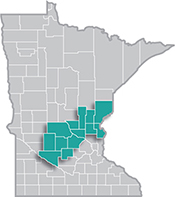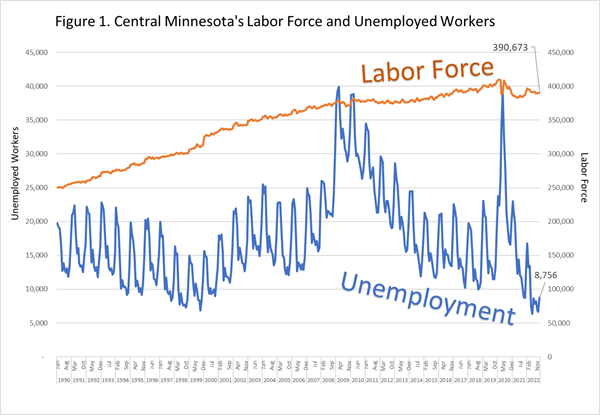 Central Minnesota is a manufacturing stronghold, with several global manufacturing firms operating there.
Central Minnesota is a manufacturing stronghold, with several global manufacturing firms operating there.
The region is especially well known for its expertise in food processing, printing, furniture manufacturing, appliances, machinery and heavy equipment manufacturing.
View our latest blogs on CareerForce. Want the freshest data delivered by email? Subscribe to our regional newsletters.
1/11/2023 9:00:00 AM
Luke Greiner
In the months prior to the pandemic, Central Minnesota was the home to just under 410,000 workers, either employed or unemployed and actively looking for work. That was a new monthly high, as the region's labor force had been steadily growing for more than a century, following regional population trends. However, implications of the pandemic caused a sudden shift in the labor market, and thousands of people left the labor force in the first year after "COVID-19" entered our lexicon.
After adding more than 100,000 workers in the 20 years preceding 2020, roughly 24,000 workers left Central Minnesota's labor force over the year from March 2020 to March 2021, a 6% decline. On an annual basis, which is the average across all 12 months, the decline was less severe but still notable. Central Minnesota averaged 401,311 workers in 2019 and then 399,966 workers in 2020, before dropping by more than 14,350 workers to 385,615 workers in 2021, the lowest number since 2015.
The region did see about 6,500 workers enter or come back into the labor force in 2022, averaging just over 392,000 workers through the first 11 months of the year. While this was a significant recovery, Central Minnesota was still down more than 9,000 workers compared to pre-pandemic levels.
To that end, another hurdle facing a return to "normal times" regarding the labor force is the shrinking number of unemployed workers. The labor force is made up of both employed workers and unemployed workers who are actively looking for work. Workers who are unemployed include people with short bouts of unemployment that occur between entering the labor market, changing jobs, or moving to a new area, which are examples of frictional unemployment. The good news is that there is essentially no structural unemployment yet, the type that occurs when industry segments lay off workers due to a recession or downward trend in the business cycle.
The bad news is employers looking to hire workers are searching for a decreasing number of available workers in a much larger economy. Despite shrinking in 2020, the labor force was 53% bigger in November 2022 compared to November 1990, but the number of unemployed workers was 34% smaller. In raw numbers, it means the region has 136,000 more workers now, but 4,500 fewer workers who were unemployed in 2022 than in 1990 (Figure 1).

In theory, this means that every worker that has entered the Central Minnesota labor force over the past 30 years has gotten a job. With the fewest number of unemployed workers to hire from in decades, employers will continue to compete for new hires and sweeten the pot to lure workers away from their current employer.
Contact Luke Greiner, Labor Market Analyst, at luke.greiner@state.mn.us